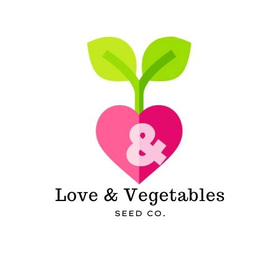60 Heirloom Seed Varieties – Only $50! 🌱 Free Shipping


How to Grow a Garden from Seed: The Love and Vegetables Way
Welcome to Love and Vegetables, where we believe growing your own food is one of the most joyful and empowering things you can do. Whether you're planting a backyard garden, filling a few pots on your porch, or sharing the experience with your kids for the first time—this guide will walk you through the basics of growing a successful garden from seed.
Why Start from Seed?
Starting your garden from seed is more than just economical—it's magical. Watching a tiny seed transform into a full-grown plant connects you to the rhythms of nature and gives you control over what you grow and eat. Plus, our heirloom seeds are open-pollinated, non-GMO, and selected for flavor, beauty, and resilience.
Step 1: Choose What to Grow
Before you get your hands dirty, ask yourself:
What do you love to eat?
How much space do you have?
How much sunlight does your space receive?
Start with easy, fast-growing crops like radishes, lettuce, beans, and herbs. Our Culinary and Kids seed packs are a great place to begin.
Step 2: Know Your Growing Zone
Use your ZIP code to determine your USDA hardiness zone. This will help you time your planting and choose varieties that thrive in your climate. We’re based in Northeast PA, Zone 6a–6b, and most of our advice is tailored to similar zones—but useful everywhere.
Step 3: Start Seeds Indoors (Optional but Recommended)
For longer-season crops like tomatoes, peppers, and eggplant, it’s best to start seeds indoors:
Use seed trays or small pots with drainage
Fill with organic seed-starting mix (light and fluffy)
Plant seeds at the recommended depth (check your packet)
Water gently and keep soil moist but not soggy
Provide light—either a sunny window or grow lights
Start 4–8 weeks before your region’s last frost date.
Step 4: Prepare Your Garden Space
Whether it’s raised beds, containers, or in-ground rows, your soil is key:
Remove weeds and loosen the soil to 6–12 inches
Mix in compost or organic matter
Rake the surface smooth
Label your rows or areas for each crop
Step 5: Direct Sow Your Seeds
Some plants do best when planted directly in the soil:
Peas
Carrots
Beets
Radishes
Beans
Follow the spacing and depth guidelines on each seed packet.
Step 6: Water, Weed, and Wait
Keep soil consistently moist, especially during germination
Weed early and often to reduce competition
Use mulch to conserve water and suppress weeds
Thin seedlings if they’re overcrowded
Patience is part of the process—growth takes time. Check on your plants daily.
Step 7: Harvest and Celebrate
Once your plants mature, harvest early and often to keep them producing. Share the bounty with neighbors, make something delicious, and take time to appreciate the magic of what you've grown.
Our Favorite Beginner Tips
Label everything—you’ll forget what you planted
Start small and build confidence
Grow what you actually want to eat
Involve your kids—they’ll love watching seeds sprout
Ready to Get Growing?
Explore our curated seed bundles, starter kits, and growing guides designed to make gardening easy, joyful, and sustainable. Sign up for our newsletter to get seasonal tips, exclusive bundles, and stories from the garden.
Love and Vegetables: Helping you grow food, community, and joy—one seed at a time.
Seeds
Quality organic non-GMO vegetable seeds for sale.
Shop
Grow
seed@loveandvegetales.com
+1 (570) 212-9613
© 2025. All things considered.
